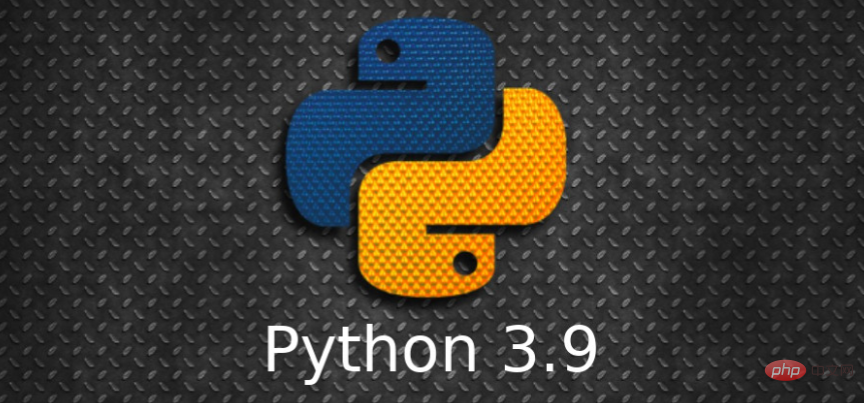终于介绍Python 3.9
Nov 19, 2020 pm 05:21 PM今天python教程栏目介绍Python 3.9。

Python 3.9,来了!
过去一年,来自世界各地的开发者们一直在致力于Python3.8的改进。Python 3.9 beta版本已经存在了一段时间,第一个正式版本于2020年10月5日发布。
每个Python版本都包含新开发和改进的功能,Python 3.9也不例外。

【python学习交流群】
下面介绍Python 3.9几个主要的新功能。
1. 字典(合并&更新)运算符
字典是Python中最基础的数据结构之一,并且随着python版本的迭代,性能得到不断地优化。
Python3.9中,合并(|)和更新(|=)运算符已添加到dict类中。这些更新完善了现有的dict.update和{** d1,** d2}方法。
传统合并字典的方法:
>>> pycon = {2016: "Portland", 2018: "Cleveland"} # 字典1>>> europython = {2017: "Rimini", 2018: "Edinburgh", 2019: "Basel"} # 字典2# 方法一>>> {**pycon, **europython}{2016: 'Portland', 2018: 'Edinburgh', 2017: 'Rimini', 2019: 'Basel'}#方法二>>> merged = pycon.copy>>> for key, value in europython.items:... merged[key] = value...>>> merged{2016: 'Portland', 2018: 'Edinburgh', 2017: 'Rimini', 2019: 'Basel'}复制代码这两种方法都合并了字典而不更改原始数据。请注意,字典1中“Cleveland”已被合并的字典2中“Edinburgh”覆盖。
你也可以更新字典1:
>>> pycon.update(europython)>>> pycon{2016: 'Portland', 2018: 'Edinburgh', 2017: 'Rimini', 2019: 'Basel'}复制代码新版本的Python引入了两个新的字典运算符:合并(|)和更新(|=)。你可以使用|合并两个字典,而|=用于更新字典:
>>> pycon = {2016: "Portland", 2018: "Cleveland"}>>> europython = {2017: "Rimini", 2018: "Edinburgh", 2019: "Basel"}>>> pycon | europython # 合并{2016: 'Portland', 2018: 'Edinburgh', 2017: 'Rimini', 2019: 'Basel'}>>> pycon |= europython # 更新>>> pycon{2016: 'Portland', 2018: 'Edinburgh', 2017: 'Rimini', 2019: 'Basel'}复制代码d1|d2和{** d1,** d2}的作用类似,都用于合并字典取并集,遇到相同key,后者会将前者覆盖。
使用|的优势之一是它适用于类似字典的类型,并在合并后保持原来的类型:
>>> from collections import defaultdict>>> europe = defaultdict(lambda: "", {"Norway": "Oslo", "Spain": "Madrid"})>>> africa = defaultdict(lambda: "", {"Egypt": "Cairo", "Zimbabwe": "Harare"})>>> europe | africadefaultdict(<function <lambda> at 0x7f0cb42a6700>,{'Norway': 'Oslo', 'Spain': 'Madrid', 'Egypt': 'Cairo', 'Zimbabwe': 'Harare'})>>> {**europe, **africa}{'Norway': 'Oslo', 'Spain': 'Madrid', 'Egypt': 'Cairo', 'Zimbabwe': 'Harare'}复制代码|=的作用是更新字典,类似于.update:
>>> libraries = {... "collections": "Container datatypes",... "math": "Mathematical functions",... }>>> libraries |= {"zoneinfo": "IANA time zone support"}>>> libraries{'collections': 'Container datatypes', 'math': 'Mathematical functions','zoneinfo': 'IANA time zone support'}复制代码|=还可以将类似字典的数据结构用于更新:
>>> libraries |= [("graphlib", "Functionality for graph-like structures")]>>> libraries{'collections': 'Container datatypes', 'math': 'Mathematical functions','zoneinfo': 'IANA time zone support','graphlib': 'Functionality for graph-like structures'}复制代码2. 删除字符串前缀和后缀
在Python 3.9中,可以使用.removeprefix和.removesuffix分别删除字符串的开头或结尾:
>>> "three cool features in Python".removesuffix(" Python")'three cool features in'>>> "three cool features in Python".removeprefix("three ")'cool features in Python'>>> "three cool features in Python".removeprefix("Something else")'three cool features in Python'复制代码有人会说.strip方法也可以呀,但是该方法会出现误删操作:
>>> "three cool features in Python".strip(" Python")'ree cool features i'复制代码可以看到,明明想删掉结尾的单词python,但是开头的there也被删除了一部分-Th。
所以.removeprefix和.removesuffix可能更精准一些。
3. zoneinfo时区模块
zoneinfo是python3.9新引入的模块,zoneinfo可以访问Internet号码分配机构(IANA)时区数据库。IANA每年都会多次更新其数据库,这是时区信息的最权威来源。
使用zoneinfo,可以获得数据库中描述任何时区的对象:
>>> from zoneinfo import ZoneInfo>>> ZoneInfo("America/Vancouver")zoneinfo.ZoneInfo(key='America/Vancouver')
>>> from zoneinfo import ZoneInfo>>> from datetime import datetime, timedelta>>> # 夏令时>>> dt = datetime(2020, 10, 31, 12, tzinfo=ZoneInfo("America/Los_Angeles"))>>> print(dt)2020-10-31 12:00:00-07:00>>> dt.tzname'PDT'>>> # 标准时间>>> dt += timedelta(days=7)>>> print(dt)2020-11-07 12:00:00-08:00>>> print(dt.tzname)PST复制代码4. 内置集合类型用于类型提示
在类型提示中,现在可以将内置集合类型(例如list和dict)用作泛型类型,而不必从typing中导入相应的大写类型(例如List或Dict)。
def greet_all(names: list[str]) -> None:for name in names:print("Hello", name)复制代码5. 拓扑排序
Python 3.9添加了一个新的模块graphlib,其中包含graphlib.TopologicalSorter类,以提供执行拓扑排序的功能。
>>> dependencies = {... "realpython-reader": {"feedparser", "html2text"},... "feedparser": {"sgmllib3k"},... }...>>> from graphlib import TopologicalSorter>>> ts = TopologicalSorter(dependencies)>>> list(ts.static_order)['html2text', 'sgmllib3k', 'feedparser', 'realpython-reader']复制代码6. 最小公倍数(LCM)
Python长期以来一直具有用于计算两个数字的最大公约数(GCD)的功能:
>>> import math>>> math.gcd(49, 14)7复制代码
最小公倍数(LCM)与最大公约数(GCD)有关,可以根据GCD定义LCM:
>>> def lcm(num1, num2):... if num1 == num2 == 0:... return 0... return num1 * num2 // math.gcd(num1, num2)...>>> lcm(49, 14)98复制代码
在Python 3.9中,不再需要定义自己的LCM函数,它新增了计算最小公倍数功能:
>>> import math>>> math.lcm(49, 14)98复制代码
7. 更强大的Python解析器
Python 3.9最酷的功能之一是大家在日常编程中不会注意到的功能,那就是解析器的更新。解析器是Python解释器的基本组件。在最新版本中,解析器已重新构建。
Python之前一直使用LL(1)解析器将源代码解析为解析树。你可以将LL(1)解析器视为一次读取一个字符,并解释源代码而无需回溯的解析器。
新解释器是基于PEG(parsing expression grammar)实现的,并非LL(1)。新解析器的性能可以与旧解析器媲美,在设计新语言功能时,PEG比LL(1)更灵活。
在整个标准库中,PEG解析器稍快一些,然而也使用了更多的内存。实际上,使用新解析器时,很难能感知到性能的好坏。
相关免费学习推荐:python教程(视频)
Atas ialah kandungan terperinci 终于介绍Python 3.9. Untuk maklumat lanjut, sila ikut artikel berkaitan lain di laman web China PHP!

Artikel Panas

Alat panas Tag

Artikel Panas

Tag artikel panas

Notepad++7.3.1
Editor kod yang mudah digunakan dan percuma

SublimeText3 versi Cina
Versi Cina, sangat mudah digunakan

Hantar Studio 13.0.1
Persekitaran pembangunan bersepadu PHP yang berkuasa

Dreamweaver CS6
Alat pembangunan web visual

SublimeText3 versi Mac
Perisian penyuntingan kod peringkat Tuhan (SublimeText3)

Topik panas
 Bagaimana saya menggunakan sup yang indah untuk menghuraikan html?
Mar 10, 2025 pm 06:54 PM
Bagaimana saya menggunakan sup yang indah untuk menghuraikan html?
Mar 10, 2025 pm 06:54 PM
Bagaimana saya menggunakan sup yang indah untuk menghuraikan html?
 Cara Menggunakan Python untuk Mencari Pengagihan Zipf Fail Teks
Mar 05, 2025 am 09:58 AM
Cara Menggunakan Python untuk Mencari Pengagihan Zipf Fail Teks
Mar 05, 2025 am 09:58 AM
Cara Menggunakan Python untuk Mencari Pengagihan Zipf Fail Teks
 Pengenalan kepada Flask: Menambah halaman kenalan
Feb 28, 2025 am 10:03 AM
Pengenalan kepada Flask: Menambah halaman kenalan
Feb 28, 2025 am 10:03 AM
Pengenalan kepada Flask: Menambah halaman kenalan
 Cara Bekerja Dengan Dokumen PDF Menggunakan Python
Mar 02, 2025 am 09:54 AM
Cara Bekerja Dengan Dokumen PDF Menggunakan Python
Mar 02, 2025 am 09:54 AM
Cara Bekerja Dengan Dokumen PDF Menggunakan Python
 Cara Cache Menggunakan Redis dalam Aplikasi Django
Mar 02, 2025 am 10:10 AM
Cara Cache Menggunakan Redis dalam Aplikasi Django
Mar 02, 2025 am 10:10 AM
Cara Cache Menggunakan Redis dalam Aplikasi Django
 Bagaimana untuk melakukan pembelajaran mendalam dengan Tensorflow atau Pytorch?
Mar 10, 2025 pm 06:52 PM
Bagaimana untuk melakukan pembelajaran mendalam dengan Tensorflow atau Pytorch?
Mar 10, 2025 pm 06:52 PM
Bagaimana untuk melakukan pembelajaran mendalam dengan Tensorflow atau Pytorch?









